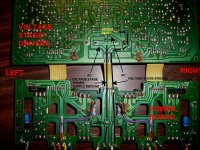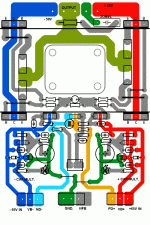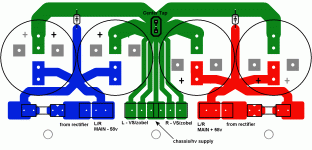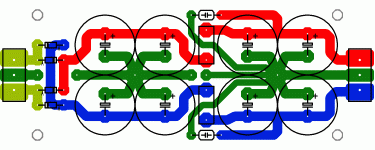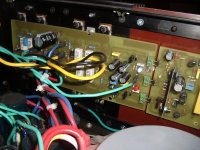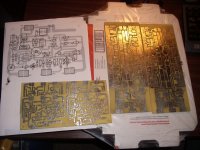OS,
Would you mind telling us what your favorite design is (schematic) sonically, forgetting the numbers for a moment and then tell us if you have found any correlation between the numbers (and topology) and the best sounding design.
Regards,
Jam
Would you mind telling us what your favorite design is (schematic) sonically, forgetting the numbers for a moment and then tell us if you have found any correlation between the numbers (and topology) and the best sounding design.
Regards,
Jam
OS,
Would you mind telling us what your favorite design is (schematic) sonically, forgetting the numbers for a moment and then tell us if you have found any correlation between the numbers (and topology) and the best sounding design.
Regards,
Jam
Well .. I can't say MY amps sound the best. 😀 I can say what impressions I have derived from building a few. The AX-TMC / BX are the best sounding for general listening. You can listen all day and not even notice the amp. You can listen to headphones then the amp and hear little or no difference. You can listen to the amp through a 220R resistor , looking for some shortcomings , and find none. At VERY high volumes , the AX holds on to it's "firstwatt sound". This must be TMC at work , I think this is why the AX is "the one" 🙂
Driving subs and the bass units at the local church is the "EX" , similar to the supersym and goldmund ... this topology seems to produce the best bass response. Some would debate whether amps even sound different at all ?? I can switch between one or the other in 60 seconds using the same PS and OPS. THERE IS A DIFFERENCE , not absolutely striking and sometimes a "selective difference" (which speaker is used , bass or fullrange use). In other words , some amps will sound better on inefficient speakers (damping factor/PS)... like in a sealed sub enclosure , some will be glorious on 8" ported 2- ways with 92db efficiency. The power supply is a real big factor , I have taken a weak sounding OEM discrete and jury rigged it up to my 60Kuf PS100 ... it sounded truly different. 😱
Numbers by themselves mean NOTHING. The simulated FFT (H2/3/5/7) is a much better benchmark to predict the end result , although very low THD 20 is a good benchmark to determine how clear your soundstage will be at concert levels. All too subjective to me , build it , listen to it , change it if need be , your ears are the final judge. Someone else tellin' me this amp sounds better ... that one sounds better ... B$. Only way is to build /listen , build /listen. Scope and Simulator can get you reliable circuitry , but cannot predict or guarantee good, pleasing sound. 😕
OS
Ahh, this made me think of the old, gutted TEAC chassis I have in the loft 🙂 Sadly no time and especially no money to do anything with it 🙁
Build & listen, listen, listen . . .
OS.
I can only 100% agree with You ....
CB
Well .. I can't say MY amps sound the best.
Numbers by themselves mean NOTHING. The simulated FFT (H2/3/5/7) is a much better benchmark to predict the end result , although very low THD 20 is a good benchmark to determine how clear your soundstage will be at concert levels. All too subjective to me , build it , listen to it , change it if need be , your ears are the final judge. Someone else tellin' me this amp sounds better ... that one sounds better ... B$. Only way is to build /listen , build /listen. Scope and Simulator can get you reliable circuitry , but cannot predict or guarantee good, pleasing sound.
OS
OS.

I can only 100% agree with You ....
CB
I took longer that I would have expected , but I am not disappointed. The unit was in excellent shape externally (pictures 1-4).
. . . OS
Hi man! If you want to refresh that cabinet, silver lacquer will work for power meter's plastic bezel, and black sandpaper (in straight lines) can put a "silver face" grain on the front aluminum and that can be easily shot with clear lacquer. Since the power meter display element is black, perhaps it needs blended in with black automotive pinstripes upon the silver face, 1/8" at near top and bottom of amp face, plus do the handles in black lacquer (plus clear). It would be most efficient to re-spray the black cabinet wrap with black lacquer (and then a shot of clear).
That prospect shouldn't be time wasting, since the lacquer shoots with just simple green + alcohol + sos pad for prep, and color lacquer paints with incomplete coat (wait a few minutes) incomplete coat (wait a few minutes--slightly more than before, but not more than 20) and then clear coat. If multiple clear coat, wait 15 to 20 minutes between clear coats to prevent run/sloughing.
This puts the risk of run at the clear coat, which minimizes risk since minor runs don't show on clear coats. 🙂 Final drying time is approximately 24 hours, and at 72 hours, its nearly indestructible. If you make a run in color lacquer, attempt to remove it immediately because it becomes fuel resistant and glassy hard in 3 days. Don't fill up the screws. 🙂 So, whatever you do with lacquer, its going to be fast.
By the time the electronics are done, if fine tuning a couple of days, the finish work has now dried to a knockout beautiful glass hard gloss. 🙂
Re-painting is usually a comedy of small errors, so just remember that the point is to make an improvement, and that absolute perfection is unlikely. Its greatly easier to paint surfaces that face UP so that runs are minimized--just hold the can so that it can't "see" vertical surfaces. 🙂
A greater number of thinner coats greatly minimizes risk.
In short order, the silver face will turn out unbelievably more shiny than anyone's disco ball, and the handles + cabinet wrap will turn out piano gloss glowing black.
There are other things possible, but this method is especially doable because its fast.
Alternative to lacquer is rust-o-lium enamel. Spray on, let set for 30 minutes or so, then bake in oven at 250deg f or so for 1/2 hour. Hard shiny tough finish ensues. I bake in the bbq to keep SWMBO happy. Just be careful not to overheat and do wait a bit before heating, solvents have to partially evaporate, otherwise the paint film skins over, traps solvent and blisters.
We are getting off topic a bit here, but the Rostoleum "appliance Epoxy" available at Homo-Depot is a great high-gloss finish. No baking required, but a LONG dry time. Make sure there is NO dust in the air. The black gives a piano-laquer look as-is, and blocking and buffing after can really make it lok like spilled oil...
Elegant , huh ? More like "well researched". I studied the original Nikko amp to see how they implemented the dual supply. NO cap multiplier .. just a bridge and 2 caps. I was surprised to see no .1uF decoupling caps in either the low or high power supplies. (Below 1 ) I will have separate cap multipliers per channel fed by a single 65-0-65Vdc supply (1kuf - same as the nikko). . .
Does separate cap multi's make "dual mono" (monoblocs) presentation?
TOO MANY Choices 😱 ... I would ask for comments on whether I should run the drivers unregulated or filtered by the cap multiplier?
Do they have gain? If so then you have one possible (and most likely) answer.
Possibly, thermal management is an issue? So. . .
The other answer is "improve the unregulated" for 1 or 2 volts less noise, which, if expressed as a percentage is a rather large and cooler difference. I posted several optional "tuner style" mods for the unregulated section of the Patchwork cap multi, just to give it less of a workout, possibly a bit less heat output. Sure, those unregulated power supply mods (the unregulated section of a capmulti supply) will work fine for running amplifier output devices off the unregulated section. That is almost the same task.
Well .. I can't say MY amps sound the best. 😀 I can say what impressions I have derived from building a few. The AX-TMC / BX are the best sounding for general listening. You can listen all day and not even notice the amp. You can listen to headphones then the amp and hear little or no difference. You can listen to the amp through a 220R resistor , looking for some shortcomings , and find none. At VERY high volumes , the AX holds on to it's "firstwatt sound". This must be TMC at work , I think this is why the AX is "the one" 🙂
. . . Only way is to build /listen , build /listen. Scope and Simulator can get you reliable circuitry , but cannot predict or guarantee good, pleasing sound. 😕
OS
The highest form, your AX, is when art and science meet and work together, applied to perform a well defined function.
First watt sound? Well, I think that your/our old M-audio card can demonstrate quickly the effect of excess current capacity that's not used up. The big rich really rockin presentation from the high current capacity silver jack is a bit different from its weaker line output jack. So, there must be such a thing as "current headroom" rather than just simply current capacity.
P.S.
Sorry that these are the best things I can think up today.
Last edited:
bY Danielwritesback - Does separate cap multi's make "dual mono" (monoblocs) presentation?
Not true dual mono , but the amp's native PSRR is increased by 6-12db. I have simulated - 90 - 100+db psrr (10-20khz) with the AX and a simple 1st order cap multiplier. In real life this approaches a true dual mono setup.
I WANT the -115db hum and noise of the Nikko !! I have "stolen" (assimilated) the best ideas and layout style of this fine Japanese amplifier. Below (pix 1) , you can see the grounding and general layout of the Nikko. I know I have been on the right track , as this amp (in the picture) used separate grounds for the unregulated driver supply and the actual ground reference of the VAS/input stage. The only decoupling for that VAS/input stage is 2 - .1uf poly caps ... just like you would use for a op-amp. 🙂
MY VERSION , which will also be in the "kit" , uses the best I have done plus a few tricks of the Nikko. Below .. (pix 2) , my power board has the addition of a simple single order cap multiplier. the VBE and it's trimmer are smack dab in the middle.
******
blue=V-
red= V+
light blue= negative OPS drive
orange=pos. OPS drive
green=ground
yellow = output
*******
The separate 65v (higher voltage) power supply (separate board) , the Zobel's, and the actual voltage stage will have separate ground returns to the amps main star ground.
My low voltage supply (+/-58V) will be 4 X 8200uF@100V (16,400uf X 2) versus the Nikko's 15Kuf , my High voltage supply (+/- 65V) will be 8 X 470uF @100V (2k X2) double the original. PS boards are next (simple).
OS
Attachments
Sweet OS,
You have a gift for extracting the best bits of what you are presented with.
Very commendable for sure!
You have a gift for extracting the best bits of what you are presented with.
Very commendable for sure!
Better "bits"
It really is good to have run into SO many amps (repair) and have so many manuals. If you correlate the products that have the best MTBF , produce the sweetest sound (and reviews) .. you see certain trends in the design.
If you listen to every enthusiast in the forums , read the good books , you will get both some conflicting advice and a FREAKIN' HEADACHE. The rich neighbor with the BOSE 301's has the Nikko alpha 220 which I recapped. WOW , this is a amp which I have used as a reference ,20 year old stuff still sounds better than most new keeerap. Different league , any volume. This amp is also a Goldmund type topology (Balanced VAS) ..like the EX .. 😀 Compared to our DIY creations , these OEM's are actually less refined (NO HF decoupling , single pair brute force caps and HV caps) NO CRC's/CLC's , cheap PCB's .... just impeccable power and grounding layout. This seems to be the "magic" in this case , the circuit is dang simple ...it even uses the lower Vce versions of my 1381/3503 pair + , even the actual 1845/992 pair.
Below, (pix 1) .. I "borrowed" the general layout for my brute force supply from the Nikko but added 2 more caps (32,800uF total) .. better ESR , higher voltage (will last 20 years - 58v on 100v caps 😀 ) . (Pix 2) is the smaller 65V supply , I went hog wild with the star grounding (fun , fun 😀😀 ) and added a 8 cap super CRC to the mix. My drivers will be "sippin' on the good stuff". Cap multipliers also "sip" on that 8 cap super low ESR CRC board (preamp style 🙂 ).
READY TO GO with the acid/peroxide tommorrow. 🙂
OS
It really is good to have run into SO many amps (repair) and have so many manuals. If you correlate the products that have the best MTBF , produce the sweetest sound (and reviews) .. you see certain trends in the design.
If you listen to every enthusiast in the forums , read the good books , you will get both some conflicting advice and a FREAKIN' HEADACHE. The rich neighbor with the BOSE 301's has the Nikko alpha 220 which I recapped. WOW , this is a amp which I have used as a reference ,20 year old stuff still sounds better than most new keeerap. Different league , any volume. This amp is also a Goldmund type topology (Balanced VAS) ..like the EX .. 😀 Compared to our DIY creations , these OEM's are actually less refined (NO HF decoupling , single pair brute force caps and HV caps) NO CRC's/CLC's , cheap PCB's .... just impeccable power and grounding layout. This seems to be the "magic" in this case , the circuit is dang simple ...it even uses the lower Vce versions of my 1381/3503 pair + , even the actual 1845/992 pair.
Below, (pix 1) .. I "borrowed" the general layout for my brute force supply from the Nikko but added 2 more caps (32,800uF total) .. better ESR , higher voltage (will last 20 years - 58v on 100v caps 😀 ) . (Pix 2) is the smaller 65V supply , I went hog wild with the star grounding (fun , fun 😀😀 ) and added a 8 cap super CRC to the mix. My drivers will be "sippin' on the good stuff". Cap multipliers also "sip" on that 8 cap super low ESR CRC board (preamp style 🙂 ).
READY TO GO with the acid/peroxide tommorrow. 🙂
OS
Attachments
. . . my High voltage supply (+/- 65V) will be 8 X 470uF @100V (2k X2). . .
OS
That's just like 1880uF series to a speaker. Is it enough to fully support 4 ohm speakers? Sorry to ask, but I'm having a doubt.
That's just like 1880uF series to a speaker. Is it enough to fully support 4 ohm speakers? Sorry to ask, but I'm having a doubt.
Dan ,the HV supply , used only on the more "elite" class of amps (Goldmund , nikko , a few others), Does not directly feed current into the loudspeakers. It ,at a higher voltage , independently feeds the drivers and voltage stages/cap multipliers. The loud speakers are fed separately by the "brute supply" (58-0-58v with the 32,800 uf capacitance). This relieves the low current stages of the massive ripple caused by driving the reactive load of the loudspekers.
Think of it as a small chip-amp with a separate supply driving a larger chip-amp who's only job is as a current amplifier. The advantages are quite oblivious.
OS
...
The advantages are quite oblivious.
OS
Sadly, it happens all too often..... 😉
Too much work , but it will be worth it. (for everybody)
I have been etching away.. whew !! I do like my PB250's (below 1) , but they are too big .. I don't need 500 watt peaks. 😱 SO , all my big Mongrels will find "new homes". I was going to replace my present 250's with the "H" model (below 2) , but these will also find a new home (ready to ship).
Now , I am going to devote myself to 2 amps .... the AX and the EX. Both will be complete in PCB form with cap multipliers and dual PS capability. Wait till I get the Nikko (the prototype) going to assure that everything is perfect.
I won't be a prick !!! I will show the final AX and EX PCB work on this forum and offer intelligent answers to any questions/problems ??. Any of my previous modular designs are fully tested and If anybody wants one ...PM me. I now have to design the Final AX and EX (more fun) , I promise to make them 110% (the best of the best 😀 ) in both economy and layout.
OS
I have been etching away.. whew !! I do like my PB250's (below 1) , but they are too big .. I don't need 500 watt peaks. 😱 SO , all my big Mongrels will find "new homes". I was going to replace my present 250's with the "H" model (below 2) , but these will also find a new home (ready to ship).
Now , I am going to devote myself to 2 amps .... the AX and the EX. Both will be complete in PCB form with cap multipliers and dual PS capability. Wait till I get the Nikko (the prototype) going to assure that everything is perfect.
I won't be a prick !!! I will show the final AX and EX PCB work on this forum and offer intelligent answers to any questions/problems ??. Any of my previous modular designs are fully tested and If anybody wants one ...PM me. I now have to design the Final AX and EX (more fun) , I promise to make them 110% (the best of the best 😀 ) in both economy and layout.
OS
Attachments
Last edited:
- Home
- Amplifiers
- Solid State
- The MONGREL (supersym II)
